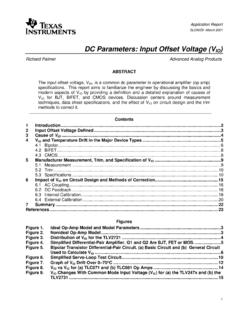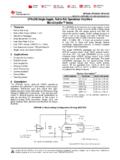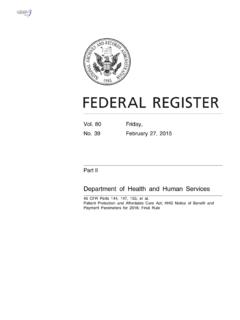Transcription of GUIDELINES FOR DESIGNING PRIMERS - Oomycete World
1 primer GUIDELINES , Howard Judelson, , p. 1. GUIDELINES FOR DESIGNING PRIMERS . Proper primer design is important for applications in PCR, DNA sequencing, and hybridization. Here are some tips to help you design PRIMERS , especially using the Oligo program. This is based upon Oligo ; there may be some changes compared to the current version. A. General recommendations The ideal primer generally has the following characteristics: 1. Melting temperature (Tm) between 55 and 65 C (usually corresponds to 45-55%. G+C for a 20-mer). 2. Absence of dimerization capability. 3. Absence of significant hairpin formation (usually >3 bp).
2 4. Lack of secondary priming sites in the template. 5. Low specific binding at the 3' end, to avoid mispriming. Usually a 20-24 nt primer works well. Oligo (as well as other programs) will pick decent PRIMERS automatically. However, often the standard parameters used by such programs don't work with a given sequence. In such a case, PRIMERS need to be picked manually. The following hints should help in this process: B. Melting (and annealing) temperatures As mentioned above, a Tm of 55-65 C works best in most applications. You may have noted that there are different ways to calculate Tm.
3 The nearest neighbor thermodynamic calculation is the most accurate (make sure that you are looking at reaction conditions appropriate to your experiment (PCR, sequencing, etc.). Oligo will calculate Tm's for you (from the pull-down menus, select Analyze, then Composition and Tm): For automated sequencing, PRIMERS with Tm's above 65-70 C can lead to secondary priming artifacts and noisy sequences. Remember, the sequence facility doesn't tailor the reactions to your specific primer as they use a generic annealing temperature. Remember that you are dealing with TWO PRIMERS in PCR. Their Tm's should be within 5 C of each other; the closer the better!)
4 If Tm's are mismatched, amplification will primer GUIDELINES , Howard Judelson, , p. 2. be inefficient: the primer with the higher Tm will misprime at lower temperatures, while the primer with the lower Tm may not work at higher temperatures. If the Tm difference is high, add or subtract bases from a primer . An easy way to see if two PRIMERS have similar Tms using Oligo is to use the Analyze>DNA Amplification command in Oligo, which will show the Tms of both PRIMERS at the same time. Note that Tm is calculated at 50 mM salt, which is standard for PCR. If you were using labelled oligonucleotides for hybridizations in SSPE, you would need to calculate Tm differently (the Oligo program can also show a table that adjusts for differences in salt and formamide).
5 The annealing temperature (Ta) for a primer pair is generally calculated as 5 C lower than the estimated melting temperature. The optimal temperature for PCR often needs to be determined empirically; ideally, the PRIMERS should anneal to the template before the template reanneals to itself. One way you can get into trouble DESIGNING PRIMERS is if you use AT-rich PRIMERS that flank a GC-rich region of DNA in PCR. Oligo will warn you of such problems, as well as suggest an optimal annealing temperature as shown above. A special case in primer design (for PCR) is when you need to add extra bases to a primer , for example a restriction site.
6 Typically one might design a primer that contains 18 nt perfectly matching the template, plus 6-nt representing the restriction site, and then about 2-nt more to assist in the restriction digestion (some enzymes need to "sit" upon a sequence larger than the restriction site itself; see the New England Biolabs catalog for more information). With this type of primer , there are essentially two different Tm's. Initially, the 18-nt region matching the template will define the Tm. After several rounds of PCR, most template will have incorporated the primer site, so the entire primer length will define the Tm.
7 For optimal results, one might consider doing a two-phase PCR program, shifting the Tm up by a few degrees after 5-10 cycles, however this may not really be necessary; consider doing this if the amplification appears to be working poorly. primer GUIDELINES , Howard Judelson, , p. 3. One way to start off with PRIMERS of similar Tms is to use the Tm and G windows in Oligo as a guide to select candidate PRIMERS . The scale at left indicates the G of hybridization (this can be toggled to Tm if you wish), based on the size of the primer currently selected (press L to see that size) It is easy to see that the Tm of the left (upper) primer is going to be higher than that of the lower primer .
8 Either the lower primer should be fitted to another region, or made longer. C. Specificity Apart from Tm, a prime consideration in DESIGNING PRIMERS is ensuring that the likelihood of annealing to sequences other than the chosen target is very low. This can occur if the same sequence is present in the template DNA more than once, or when a primer is poorly designed. To avoid mispriming, PRIMERS should not be very sticky on their 3' ends. A "sticky" 3'. end would be one with a high G/C content (high Tm). Either the middle of the primer or the 5' end should be "stickier". The display in Oligo makes it easy to pick PRIMERS with good specificity, by using the Internal Stability window at the bottom of the screen or the Analyze>Internal Stability command (both are shown below).
9 For example, the following primer (5'-CAGTAACAGA TACGGGCA) would show poor specificity since its 3' end is GC rich relative to the rest of the primer . NOTE that the issue is the 3' end region, not just the 3' base!! BAD!!! BAD!!! primer GUIDELINES , Howard Judelson, , p. 4. In contrast, the following profiles are good for specificity (shown 5' >3'), since the 3'. end is lower (in this G plot) than the 5' end or middle of the PRIMERS : Now what about the profile shown below? This would appear to give good specificity, based on the rules mentioned above. However, in practice this would be a difficult primer to use since at it's Tm the 3' end would anneal poorly to the template (remember that Tm is the 50% point in a melting curve).
10 This brings up the rule of extremes in primer design: Avoid PRIMERS with long polyG or polyC stretches that can promote non-specific annealing. Avoid polyA and polyT as these will breath and open the primer -template complex. Avoid polypyrimidine (T, C) and polypurine (A, G) stretches, which may lead to an odd shape of the double helix. Ideally the primer will have a near random mix of nucleotides. D. What about having a GC clamp at the 3' end? A "G" or "C" is desirable at the 3' end of PRIMERS since this will reduce breathing and thereby increase yield. However, Gs or Cs should not be added if they adversely influence the overall specificity of the primer !








